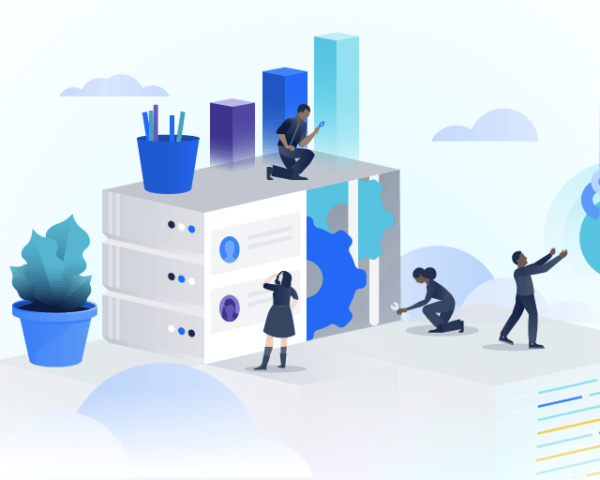Atlassian started designing for a cloud-first future a decade ago, with the goal of helping teams and businesses deliver at the pace the market demands. The advantages of cloud are clear: SaaS products are more reliable, reduce the risk of downtime, reduce management costs, and free up the time spent on maintenance to provide better experiences for end-users.
When we help enterprise customers choose the best deployment option, we know they often have their own list of requirements. Most often, these include:
- Ensuring the privacy and security of their company’s data
- Meeting strict compliance and regulatory requirements
- Supporting their teams as they scale
- Accelerating access to innovation with effective change management
- Finding new ways to modernize their practices and processes
Over the last few years, we’ve made significant investments in our cloud platform’s security, scalability, extensibility, and product functionality to meet these needs and more – but there’s more work to be done. Keep reading to get up to speed on how our cloud platform currently stacks up across these core requirements and learn about our plans for the future.
Advantages of Atlassian cloud vs. hosting through third-party providers
Before we dive in, it’s important to clarify how our cloud products are different from our self-managed products that are hosted through public cloud services like AWS and Azure.
Cloud is our Atlassian-managed SaaS offering. Rather than installing and maintaining our products on your own servers, we host, set up, secure, and maintain your products in the cloud for you. Our cloud platform is built on AWS, so our products have some of the inherent benefits available on the AWS platform, in addition to the enhancements we’ve made to our architecture.
Atlassian cloud is purpose-built to ensure enterprise-grade security and reliability for Atlassian products. Because of how SaaS technology works, cloud is a platform that grows with you, integrates with all your tools, and gets smarter and faster every day to provide the best experience for your teams.
Because we’re running things for you, we ensure that your products are always available with financially backed SLAs, while optimizing the cloud platform to maintain performance. We run our security program in compliance with a range of well-known industry standards and regulations so you can feel confident that your company and customer data remain secure and compliant. Atlassian is focused on giving you the tools to innovate and optimize your team’s experience.
If your organization requires complete control over your data, you can deploy Data Center on IaaS (or host on-premise). Cloud vendors like AWS and Azure can help you adapt to the challenges of operating a self-managed environment at scale. However, it’s important to note that while we will continue to ship new features to enhance the admin experience in both Data Center and cloud, our cloud customers will also benefit from innovation efforts to improve the end-user experience.
With Data Center, our self-managed enterprise offering, you install, host, and run our products yourself, either on your own hardware or through public cloud hosting services like AWS and Azure. In that case, you get a lot of the benefits of being on the cloud, but you’re still in charge of your data.
Data Center is a reliable, long-term enterprise option if you wish to remain in a self-managed environment. Like your server products, you have control over data management, security, and compliance, as well as when you upgrade to the latest features. However, one of the key differences from server is that we’ve built Data Center for scale, investing in additional platform enhancements and admin controls, such as CDN support and rate-limiting, to help you improve performance and uptime.
How does Atlassian cloud stack up against your requirements?
Many of our enterprise customers are already using and benefitting from SaaS tools in some capacity, and as the adoption of those tools has spread, businesses are seeing ever greater ROI and are able to deliver value to their customers faster.
But many other enterprise customers have been managing their Atlassian products on-premise for years. Deciding if and how to migrate to cloud requires thoughtful consideration and trust in Atlassian – trust that we need to consistently earn and keep.
1. Ensuring the privacy and security of your company’s data
Considering a move to our cloud products starts with ensuring that you can trust Atlassian with the security and management of your company’s data. In a recent Cloud Security Alliance survey, 34 percent of respondents said their hesitancy to jump to the cloud is rooted in a sense of loss of control over the management of data and IT services.
Data privacy and security: We’re committed to adhering to industry best practices to protect you and your customers’ data from unauthorized access. We run our security program in compliance with a range of well-known industry standards, including SOC2, ISO27001, ISO27018, PCI DSS, CSA STAR, and GDPR, with support for more standards in the works (including FedRAMP, HIPAA, NIST). Our products regularly undergo third-party audits of their security, privacy, and compliance controls and should meet the needs of the majority of our customers. Our cloud products are encrypted both in transit and at rest* (*Bitbucket does not offer encryption at rest for repositories at this time).
Centralized security and governance: You can also add a layer of security to enforce organization-wide protection through SAML single sign-on (SSO) and two-factor auth (2FA) with Atlassian Guard. Use the organization audit log within Guard to diagnose problems or find answers to questions related to user details, product access, managed accounts, and organization settings. Our roadmap is focused on continuing to meet enterprise-grade data security and compliance requirements by investing in advanced features, including bring-your-own-key (BYOK) edge data encryption.
Security is all about depth in defense, so we’ve been working with leading app security vendors like McAfee to integrate our audit logs supporting a layer of added security with DLP capabilities.
While sometimes hosting applications on-premise or on a private cloud server is required, I hope we can help customers realize that the economies of scale that cloud provides also improve security. We create highly tuned monitoring for cloud instances, we can patch the cloud quickly (because we have direct access to them), and we implement tighter controls around direct access to data (e.g. insider threat).
Adrian Ludwig, Chief Information Security Officer, Atlassian
2. Meeting strict compliance and regulatory requirements
Beyond security, we know that government regulations on data privacy and your compliance with those regulations is critical.
GDPR: If you reside in the EU, we know GDPR compliance is a major consideration. We are GDPR compliant, and our privacy team is constantly monitoring the legal landscape to ensure we’re meeting your requirements.
Data residency: For many who work in highly regulated industries, data residency is non-negotiable. Today, we offer data residency as part of our Cloud Enterprise plan, starting first with support for the EU and US regions. Soon, data residency will also be available as part of Standard and Premium cloud plans. We also plan to support additional regions, including Australia, Japan, the UK, and Canada. We are also working with our Marketplace partners to expand data residency capabilities and offer data residency for their apps when possible. Learn more about our data residency strategy in this community post.
Highly regulated industries: We have big plans to meet the compliance requirements for some of the most strictly regulated industries out there, like finance, government, and healthcare. Specifically, we plan for Jira and Confluence Cloud to be compliant with US, EU, and AUS finance standards in 2022, FEDRAMP moderate in 2023, and HIPAA compliant in 2023.
3. Supporting your teams as they scale
Our cloud products are designed for high performance and availability. They are built on best-in-class core technologies, such as AWS, so your organization can scale confidently and securely.
A key benefit of cloud is that we can invest in architecture improvements, monitoring, and redundancies at a far greater scale than any one customer. We’ve been able to increase the user limits on our cloud products fivefold in the last two years without compromising performance, and we have an aggressive roadmap for continued improvements.
If you have more than 10,000 users, we offer unlimited horizontal scale. This means you can unify an unlimited number of instances of 10,000 users each across your organization, bridging business units, departments, and regions to work in a standardized way, available via the Cloud Enterprise plan.
We’re currently running an early access program (EAP) for the next milestone in scalability – 20,000 users per instance – and plan to make this generally available by June 2021. If you’re looking to move 10-20,000 users to cloud before then, see if you’re a good fit for the EAP.
The investment we’re making in performance and scale is the single biggest initiative at Atlassian right now. This initiative is directly in support of our #1 company priority of enabling all of our on-prem customers to be able to confidently choose cloud.
Otto Ruettinger, Head of Product Management, Atlassian
4. Accelerate access to innovation with effective change management
We recognize that the dynamic nature of delivering continuous innovation requires advanced admin controls to preview, test, and prepare end users. Our program on change management is focused on building capabilities to help you feel more informed, prepared, and in immediate control of the rate of change in cloud.
Sandboxes are a direct replacement for developer license keys in server and Data Center. For each production instance, you get a fully enabled second cloud instance to test config changes, explore new features, or evaluate Marketplace apps. This will allow you to easily test any changes or new feature rollouts before they get to production, so you can ensure everything works the way it should.
Release tracks let you opt-in to updates from Atlassian in a fixed two-week window, creating additional predictability as to which changes are coming to your instance and when. This allows you to assess and test the impact of these features and inform end-users of any changes before they go into the production environment. We know we have a high bar to meet compared to the way enterprise releases work in our self-managed offerings, but rest assured we are fully committed to addressing this need.
And if you ever need support, Enterprise Support includes 24/7 support with a 30-minute initial response time for critical issues, as well as phone support with a dedicated senior team.
5. Finding new ways to modernize your teams’ practices and processes
Many of our customers depend heavily on third-party apps or custom-built integrations to improve the experience for their teams. Therefore the availability, migrate-ability, and custom extensibility of that functionality is a critical consideration when assessing a move to cloud.
App availability: Extensibility is top of mind, and we’ve shipped dozens of new Jira and Confluence APIs and extension points to help bring popular apps to cloud. Together with our Marketplace partners, we continue to bring more server apps to cloud, make the transition to cloud easier, and improve our app security and compliance. In 2020, we added over 450 new cloud apps to the Atlassian Marketplace, and 77 of the top 100 server apps are available today in cloud (either as apps or as part of our cloud product functionality).
App migrate-ability: We’ve also made it easy to assess your apps with our Jira Cloud Migration Assistant app and the Confluence Cloud Migration Assistant. These tools help you assess the apps installed on your server or Data Center instance for availability, usage, and migrate-ability to determine which ones you’ll need to migrate to cloud. We’re working closely with our Marketplace partners to build automated migration paths within the cloud migration assistants, meaning you’ll be able to migrate all of your data types (users, product data, and app data) in one workflow.
Custom apps and extensibility: For custom app development and deployment, our new cloud development platform, Forge (currently in beta and on track to being publicly available soon), empowers developers to easily build and run enterprise-ready custom cloud apps. With Forge, developers can host their apps on Atlassian cloud infrastructure, which minimizes the time, cost, and effort spent on managing infrastructure, increasing admin transparency and mitigating concerns about mishandling sensitive user data.
Watch our public cloud roadmap for announcements later this year about new automated migration paths and migration tooling for your Marketplace apps, and check out the migration assistants today to see what’s already there.
How we’re ensuring that cloud will meet your core needs
We’re knocking down your biggest blockers and investing in making the cloud migration process seamless.
In 2018, we surveyed our largest self-managed customers and asked them what we would need to offer them to move to cloud. Based on the responses, we developed a top-50 list to guide our investments. At the time of the survey, cloud met nine out of the 50 requests. Fast forward two years and we now have 26 of these features live, with most of the remaining underway. We also continue to refine this list as we take in feedback, note the blockers you share with us, and tackle them head-on.
What we’re hearing from customers who have migrated to cloud is that, overwhelmingly, they are happier – able to move faster and deliver more value for their customers. But we’re pouring our hearts and souls into eliminating the various scale, extensibility, compliance, and data privacy issues some customers experience in cloud. If there are features you need, we’d encourage you to review our cloud platform and services roadmap to see when we’ll be delivering on them. If you don’t see what you need, please don’t hesitate to reach out to us.



